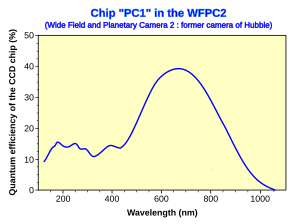
Back Eficiència quàntica Catalan Quantenausbeute German Eficiencia cuántica Spanish بازدهی کوانتومی Persian Efficacité quantique French יעילות קוונטית HE Efficienza quantica Italian 양자효율 Korean Eficiência quântica Portuguese Квантовая эффективность Russian

The term quantum efficiency (QE) may apply to incident photon to converted electron (IPCE) ratio[1] of a photosensitive device, or it may refer to the TMR effect of a magnetic tunnel junction.
This article deals with the term as a measurement of a device's electrical sensitivity to light. In a charge-coupled device (CCD) or other photodetector, it is the ratio between the number of charge carriers collected at either terminal and the number of photons hitting the device's photoreactive surface. As a ratio, QE is dimensionless, but it is closely related to the responsivity, which is expressed in amps per watt. Since the energy of a photon is inversely proportional to its wavelength, QE is often measured over a range of different wavelengths to characterize a device's efficiency at each photon energy level. For typical semiconductor photodetectors, QE drops to zero for photons whose energy is below the band gap. A photographic film typically has a QE of much less than 10%,[2] while CCDs can have a QE of well over 90% at some wavelengths.
- ^ Shaheen, Sean (2001). "2.5% efficient organic plastic solar cells". Applied Physics Letters. 78 (6): 841. Bibcode:2001ApPhL..78..841S. doi:10.1063/1.1345834. hdl:11370/108e619e-c6c2-4cf9-859e-6f937ac027f2. Archived from the original on 2012-07-07. Retrieved 20 May 2012.
- ^ Träger, Frank (2012). Handbook of Lasers and Optics. Berlin Heidelberg: Springer. pp. 601, 603. ISBN 9783642194092.
© MMXXIII Rich X Search. We shall prevail. All rights reserved. Rich X Search